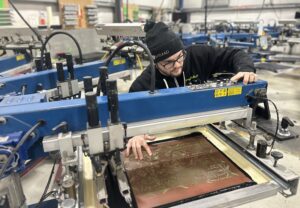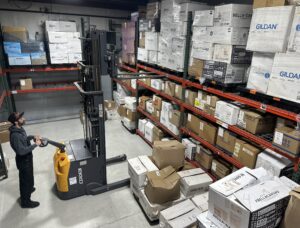Peanut butter and jelly, Sonny and Cher, screen printing and music: it’s a classic love story dating back to the birth of rock ‘n’ roll itself. And I should know, being an industry cliché myself: a screen printer who dared answer the call of the rock ‘n’ roll gods and started printing his own band’s shirts in his basement 20 years ago.
Obviously, I didn’t know what I was getting myself into with my company Axelrad Screen Printing. You would have to be crazy to start doing something like this if you did. But here I am today, printing hundreds of thousands of shirts a year for some of the biggest names in music.

Having the necessary processes in place to produce top-quality prints on deadline should be a given for anyone looking to compete in the music business. Photo courtesy of Axelrad Screen Printing
It wasn’t a linear journey. There were many necessary detours containing valuable lessons. However, the road less travelled also tends to be the most fruitful, and I can attest to the fact that while screen printing for the music industry may not be for the faint of heart, it’s worth it—if you’re brave enough.
If you decide to make the transition from printing your own band’s shirts to pursuing doing it for a living, you likely won’t have the technical capabilities to begin printing for your favorite band right away. Executing high-volume print runs quickly is an ambitious goal that requires an already well running business. You’ll have to spend time gathering more attainable clients to develop your skills: everything from your local softball league to coffee shops, high schools and maybe a lucrative local corporate account or two. Only then, after all the struggles of expanding your press capabilities, adding employees and navigating deadlines will you be ready.
Finally, there comes the day, some random Wednesday afternoon at, say, 3:40 p.m., when a well-known band e-mails and asks if you can print some designs for its upcoming tour. You’re ecstatic. It’s arrived! The moment you’ve been working toward is finally here. Of course, you say, “Yes!” without a second thought.
Only after excitedly replying do you give the e-mail in question a closer look. Are those double sleeve prints in the second PDF? Wait, there are inside tag prints too? Is that a three-color print on the side of a two-ply hood? And it’s due in three days! That initial shot of adrenaline starts to cool down. Like most things, what should have been the celebratory moment you’ve been working toward for what feels like forever proves bittersweet. Nothing good is ever easy. Sadly, screen printing is not immune from the natural laws of the Universe.
Imagine one of your regular customers, someone you’ve been building your business with for years says, “Hey, I’m not sure how many shirts I’m gonna need or what city I’ll be in when I realize I may need more, but the due dates all firm, and much of my income depends on it. Does that sound good to you?”
It’s unlikely your answer would be the same elated “yes” that it was for that well-known band. But there it is. The magic of the rock ‘n’ roll gods makes us do crazy things.
Commercial T-shirt Printing for Rock Bands
When it comes to music clients, it’s not only a given your prints are excellent, it’s a requirement for even getting into the arena. Your sales angle, therefore, quickly becomes less about quality and more about turnaround times and communication. Sure, you can print well, but can you do it tonight, accurately and have it to Cleveland by tomorrow? Equally important, you have to ask yourself: “Do you even want to have to do so?”

Don’t forget to make sure you have access to the necessary stock in advance of having to fulfill the last-minute orders you will invariably find yourself having to deal with. Photo courtesy of Axelrad Screen Printing
Accommodating the demands of the music industry, for example, will often require you to restructure the workflow you’ve already been refining for years with your other customers. Let’s say that same local coffee shop that has helped you grow your business to where it is today has an order on the schedule. Now a band you’ve been working with calls telling you they had a way better sales night in Denver than they thought they would, and they need 1,000 more tour hoodies in Salt Lake City—in two days.
You’re now at a tough crossroads. Because the local coffee shop is never going to need 1,000 hoodies this fast, let alone two time zones away, your workflow up to this point was never set up for that kind of thing. It’s now up to you if you want to continue down the rock ‘n’ roll road you originally set out on—or if you want to continue running your business the way you have been in order to even get into the game. Either way, it’s important to understand you’re going to have to develop a whole new set of procedures if you’re going to be able to accommodate the unique demands of the music industry—assuming that is that it’s still where you want to take things!
The good news is once you’ve put in place the more dynamic procedures necessary for accommodating bands on the road, the local coffee shop benefits as well. A rising tide lifts all boats. You don’t have to abandon your traditional customers. Just the opposite. Faster turnaround times and more rigorous quality control are good for all involved.
Challenges when Custom T-shirt decorating for the Music Industry
This past year we had a client sell nearly triple what they’d originally projected they would sell at the start of their summer tour. It’s hard to point fingers when there is no one to blame. Their initial projections were reasonable and accurate. I put in place a production plan based on those projections. But the rock ‘n’ roll gods had other ideas.
The only way to deal with these kinds of situation is to work with the band’s merchandising manager and create realistic expectations. It is imperative at this point that you do not over promise. Overpromising and under delivering won’t work with clients who are constantly on the move and utterly dependent on what you’ve promised them. A silver tongue only gets you in trouble in the music world. Figure out how to actually do what you’re promising, and then do it when you say you will at all costs.

The team at Axelrad spent years mastering the nuts and bolts of the craft of apparel decoration before venturing into the rock ‘n’ roll arena. Photo courtesy of Axelrad Screen Printing
Be transparent with your team, let them know what’s happening and that it’s not the fault of management. Work out reasonable rush charges with the customer and talk to your team about overtime and bonuses. Money alone won’t solve all your problems, but it certainly serves as a good starting point. That said, be aware that asking your team to step up this way typically only lasts so long before it gets old, and burnout sets in. I recommend using this option sparingly.
Taking a look at your schedule as a whole and working with the sales team to make room and move whatever other deadlines you have to accommodate the unexpected rush represents a much better starting place. It’s a fine balance, but managing your way out of these situations is far better in the long term than working your way out of them. Wearing out your team should be the last option. This is the new normal. Running down your employees over and over again won’t last.
Another situation I often encounter is a band that will initially order just enough to get it through the first week of its tour, and then use the sales from those first few dates as a projection of what it will sell for the remainder of the tour. Basically, they are guaranteeing there will be a rush reorder of an unknown size coming your way.
The most important thing to do in this case is block out your schedule, anticipate it and document every single thing you did to produce that first run so the reorder goes promptly and accurately. Bands have a terrible habit of underestimating their sales. As a general rule, expect the reorder to be at least 60 percent of the initial one.
Then there’s the question of inventory. We once had a client order so many tour shirts using natural discharge that we depleted our regional distributor’s entire stock before we were finished with the run. Inventory is incredibly important when dealing with high-volume fast turnaround times. It’s easy to get caught up in the rush and forget to check if you have enough pigment to make that specific shade of red. It sounds trivial, but it can’t be understated how important this is.
While you’re at it, package and present each order as if it’s going to be processed by the customer in the dark, in a hurry while on a truck going down the highway and 70 miles per hours. Because that’s exactly what’s going to happen. Labeling the outside of your boxes clearly and accurately is one of the most important things you can do to keep a client happy. They move fast, rely on accuracy and are always working under pressure. Most bands will depend on the counts you give them when they submit their own counts to the vendor. If your numbers are off, they look like fools, and it makes their lives that much more difficult. There’s no sooner way to lose a good client than to mess this up. If a box says it has 72 size-medium T-shirts inside, it better not be 71.
It’s also worth considering providing your own internal delivery service for your clients. Being able to control delivery times is huge. When a band is on the move and playing its most valuable shows on weekends, cutting out third-party shipping services and adding an extra layer of control can go a long way for everyone involved. Clients appreciate direct delivery, because it avoids them having to hunt down a bunch of packages that were, say, received by the venue’s cooking staff via some back-alley kitchen entrance. Who knows where those boxes ended up? Having a service that can bring the order straight to the client, at a specific time and place is invaluable and will only serve to strengthen your relationship and reputation.
Committing to Custom T-shirt Printing for the Music Industry
Being able to meet the demands of the music industry will ensure you have a long line of customers seeking the services you provide. Mastering these difficult processes will make you the company the industry wants to work with. It’s easy for bands to find shops willing to print for them, but long-term satisfaction can be very hard for them to come by. If you can provide that, it becomes the marketing message in and of itself.
In a grand sense, screen printing can sometimes to feel like a thankless endeavor, jumping through endless hoops just to get a quality shirt on someone’s back. When it comes to printing for bands, though, knowing you’re printing a shirt that has a higher likelihood of becoming a person’s favorite can provide a tremendous feeling of satisfaction. People often associate the tour shirts they buy with a great night out with friends, a first date or a band they’ve always loved and finally got to see. As printers for the music industry, we get to indirectly tap into the allure of the rock ‘n’ roll gods in all their glory.
Enjoying what you’re doing by creating products that are symbolic to a customer makes for a truly more meaningful experience. It takes a lot of focus and risk, but it’s a win-win to work on orders that both make sense to the bottom line and are satisfying for your team to produce.
Dennis Condusta currently serves as the production manager at Axelrad Screen Printing in Wilkes-Barre, Pennsylvania (axelradarmy.com). In addition to screen-printing, Axelrad provides a host of other services, including embroidery and design. Condusta is also a regular Impressions conference series presenter.
Updated 4/24/25





